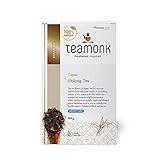
Different Types of Teas and Their Brewing Methods – Tea, the world’s second most consumed beverage after water, has a rich history dating back thousands of years.
With a vast array of flavors, aromas, and health benefits, tea has captivated cultures and palates across the globe.
In this comprehensive guide, we’ll explore the diverse world of teas, from classic black and green teas to aromatic herbal infusions.
Along the way, we’ll delve into the art of brewing the perfect cup, ensuring you savor each sip to the fullest.
Contents
1. Common Types of Tea
Tea comes in various types, each with its distinct flavor, aroma, and character. Here are the most common varieties:
A. Black Tea
- Description: Fully oxidized tea leaves, resulting in a bold, robust flavor and dark color.
- Flavor: Malty, bold, and sometimes slightly astringent.
- Popular Varieties: Assam, Darjeeling, Earl Grey, English Breakfast.
Table: Common Varieties of Black Tea
| Variety | Origin | Flavor Profile | Brewing Time | Water Temperature |
|---|---|---|---|---|
| Assam | India | Rich, bold, malty | 3-5 minutes | 200-212°F (93-100°C) |
| Darjeeling | India | Floral, muscatel notes | 3-4 minutes | 180-194°F (82-90°C) |
| Earl Grey | Blended | Citrusy, bergamot-infused | 3-4 minutes | 200-212°F (93-100°C) |
| English Breakfast | Blended | Robust, full-bodied | 3-5 minutes | 200-212°F (93-100°C) |
B. Green Tea
No products found.
- Description: Unoxidized or minimally oxidized tea leaves, preserving the natural green color.
- Flavor: Fresh, grassy, and often with vegetal notes.
- Popular Varieties: Sencha, Matcha, Dragon Well, Gunpowder.
Table: Popular Varieties of Green Tea
| Variety | Origin | Flavor Profile | Brewing Time | Water Temperature |
|---|---|---|---|---|
| Sencha | Japan | Grassy, vegetal | 1-2 minutes | 160-180°F (71-82°C) |
| Dragon Well | China | Nutty, sweet, chestnut | 2-3 minutes | 175-185°F (80-85°C) |
| Matcha | Japan | Rich, earthy, vibrant green | Whisked | 175-185°F (80-85°C) |
| Gunpowder | China | Smoky, strong | 2-3 minutes | 175-185°F (80-85°C) |
C. White Tea
- Description: Minimal processing, consisting of young leaves and buds.
- Flavor: Delicate, floral, and sweet with subtle flavors.
- Popular Varieties: Silver Needle, Bai Mu Dan (White Peony).
Table: Notable Varieties of White Tea
| Variety | Origin | Flavor Profile | Brewing Time | Water Temperature |
|---|---|---|---|---|
| Silver Needle | China | Delicate, sweet, floral | 2-3 minutes | 160-185°F (71-85°C) |
| White Peony | China | Mellow, fruity | 2-3 minutes | 160-185°F (71-85°C) |
| Snowbud | China | Fresh, vegetal | 2-3 minutes | 160-185°F (71-85°C) |
D. Oolong Tea
- Description: Semi-oxidized tea, falling between green and black tea.
- Flavor: Varies widely, from light and floral to dark and robust.
- Popular Varieties: Tie Guan Yin, Dong Ding, Wuyi Rock Tea.
Table: Noteworthy Varieties of Oolong Tea
| Variety | Origin | Flavor Profile | Brewing Time | Water Temperature |
|---|---|---|---|---|
| Tie Guan Yin | China | Floral, orchid notes | 3-5 minutes | 185-205°F (85-96°C) |
| Dong Ding | Taiwan | Roasted, fruity | 3-5 minutes | 185-205°F (85-96°C) |
| Phoenix Dan Cong | China | Complex, fruity, aromatic | 3-5 minutes | 185-205°F (85-96°C) |
E. Herbal Tea
- Description: Infusions made from herbs, spices, fruits, flowers, or other botanicals.
- Flavor: Varies depending on ingredients; can be fruity, floral, or spicy.
- Popular Varieties: Chamomile, Peppermint, Hibiscus, Rooibos.
Table: Popular Herbal Infusions
| Herb/Flavor | Flavor Profile | Brewing Time | Water Temperature |
|---|---|---|---|
| Chamomile | Floral, apple-like | 5-7 minutes | 200-212°F (93-100°C) |
| Peppermint | Refreshing, minty | 3-5 minutes | 200-212°F (93-100°C) |
| Rooibos | Earthy, nutty | 5-7 minutes | 200-212°F (93-100°C) |
| Hibiscus | Tart, cranberry-like | 5-7 minutes | 200-212°F (93-100°C) |
F. Pu-erh Tea
- Description: Fermented and aged tea, known for its earthy and complex flavors.
- Flavor: Earthy, woody, and sometimes with hints of sweetness.
- Popular Varieties: Sheng (raw) and Shou (cooked) Pu-erh.
Table: Pu-erh Tea Varieties
| Variety | Origin | Flavor Profile | Brewing Time | Water Temperature |
|---|---|---|---|---|
| Sheng (Raw) | China | Earthy, vegetal, ages well | 2-4 minutes | 195-205°F (90-96°C) |
| Shou (Ripe) | China | Smooth, mellow, fermented | 2-4 minutes | 195-205°F (90-96°C) |
2. Brewing Tea: The Essentials
To brew a perfect cup of tea, you’ll need to understand the fundamental elements of tea preparation:
A. Teapots and Infusers
Choosing the right teapot or infuser can greatly affect the taste of your tea. Here’s a quick guide:
Table: Teapots and Infusers Guide
| Equipment | Description | Common Types |
|---|---|---|
| Teapot | A vessel for steeping tea leaves. | Ceramic, glass, cast iron, clay. |
| Tea Infuser | A device to hold loose tea leaves. | Ball infusers, basket infusers, teapots with built-in infusers. |
| Gaiwan | A Chinese lidded bowl used for multiple infusions. | Porcelain, glass, clay. |
| Tea Kettle | A pot for heating water to the ideal temperature. | Electric, stovetop, variable temperature kettles. |
| Timer | To ensure precise steeping times. | Kitchen timer, smartphone timer. |
B. Water Temperature
The temperature of your water can profoundly impact the taste of your tea. Different types of tea require different water temperatures:
Table: Recommended Water Temperatures for Tea
| Tea Type | Ideal Water Temperature Range |
|---|---|
| Black Tea | 200-212°F (93-100°C) |
| Green Tea | 160-185°F (71-85°C) |
| White Tea | 160-185°F (71-85°C) |
| Oolong Tea | 185-205°F (85-96°C) |
| Herbal Tea | 200-212°F (93-100°C) |
| Pu-erh Tea | 195-205°F (90-96°C) |
C. Brewing Time
The duration of steeping time varies for each type of tea and influences flavor and strength. Proper timing ensures a balanced cup:
Table: Recommended Brewing Times for Tea
| Tea Type | Ideal Brewing Time |
|---|---|
| Black Tea | 3-5 minutes |
| Green Tea | 2-3 minutes |
| White Tea | 2-3 minutes |
| Oolong Tea | 3-5 minutes |
| Herbal Tea | 5-7 minutes |
| Pu-erh Tea | 3-5 minutes |
D. Tea-to-Water Ratio
The amount of tea leaves or tea bags you use per cup of water also affects the flavor and strength of your tea. Follow these general guidelines:
Table: Recommended Tea-to-Water Ratios
| Tea Type | Ideal Tea-to-Water Ratio |
|---|---|
| Black Tea | 1 teaspoon per 8 oz (240 ml) of water |
| Green Tea | 1 teaspoon per 8 oz (240 ml) of water |
| White Tea | 1.5 teaspoons per 8 oz (240 ml) of water |
| Oolong Tea | 1 tablespoon per 8 oz (240 ml) of water |
| Herbal Tea | 1-2 teaspoons per 8 oz (240 ml) of water |
| Pu-erh Tea | 1 tablespoon per 8 oz (240 ml) of water |
3. Brewing Methods for Different Tea Types
Each type of tea requires specific brewing methods to bring out its best qualities. Let’s explore the proper techniques for each:
A. Black Tea
Table: Brewing Black Tea
| Step | Description |
|---|---|
| 1. Boil Water | Bring fresh water to a rolling boil. Use a kettle or pot. |
| 2. Preheat Teapot | Pour a small amount of hot water into the teapot and swirl to warm it; discard the water. |
| 3. Add Tea Leaves | Measure the appropriate amount of black tea leaves (per the tea-to-water ratio) into the teapot. |
| 4. Pour Hot Water | Pour the boiling water over the tea leaves in the teapot. |
| 5. Steep | Cover the teapot and steep for 3-5 minutes. Adjust steeping time based on taste preference. |
| 6. Serve | Pour the tea into cups, and you can add milk, sugar, or honey to taste. Enjoy! |
B. Green Tea
Table: Brewing Green Tea
| Step | Description |
|---|---|
| 1. Heat Water | Heat fresh water to 175-185°F (80-85°C) and let it cool for a minute or two. |
| 2. Preheat Teapot | Preheat your teapot or teacup by rinsing it with a small amount of hot water. |
| 3. Add Tea Leaves | Measure the appropriate amount of green tea leaves into your teapot or teacup (per the tea-to-water ratio). |
| 4. Pour Hot Water | Pour the hot water over the tea leaves. |
| 5. Steep | Cover the teapot or teacup and steep for 2-3 minutes. Adjust steeping time to taste. |
| 6. Serve | Strain or remove the tea leaves, and enjoy the refreshing flavor of green tea. |
C. White Tea
Table: Brewing White Tea
| Step | Description |
|---|---|
| 1. Heat Water | Heat fresh water to 160-185°F (71-85°C) and let it cool slightly. |
| 2. Preheat Teapot | Preheat your teapot or teacup by rinsing it with a small amount of hot water. |
| 3. Add Tea Leaves | Measure the appropriate amount of white tea leaves into your teapot or teacup (per the tea-to-water ratio). |
| 4. Pour Hot Water | Pour the hot water over the tea leaves. |
| 5. Steep | Cover the teapot or teacup and steep for 2-3 minutes. Adjust steeping time as needed. |
| 6. Serve | Strain or remove the tea leaves and savor the delicate flavors of white tea. |
D. Oolong Tea
Table: Brewing Oolong Tea
| Step | Description |
|---|---|
| 1. Heat Water | Heat fresh water to 185-205°F (85-96°C) and let it cool briefly. |
| 2. Preheat Teapot | Preheat your teapot or teacup by rinsing it with a small amount of hot water. |
| 3. Add Tea Leaves | Measure the appropriate amount of oolong tea leaves into your teapot (per the tea-to-water ratio). |
| 4. Pour Hot Water | Pour the hot water over the tea leaves. |
| 5. Steep | Cover the teapot and steep for 3-5 minutes. Adjust steeping time for desired strength. |
| 6. Serve | Strain or remove the tea leaves and savor the nuanced flavors of oolong tea. |
E. Herbal Tea
Table: Brewing Herbal Tea
| Step | Description |
|---|---|
| 1. Boil Water | Boil fresh water and let it cool slightly. |
| 2. Preheat Teapot | Preheat your teapot or teacup by rinsing it with a small amount of hot water. |
| 3. Add Herbs | Measure the appropriate amount of herbal tea blend (per the tea-to-water ratio) into your teapot or teacup. |
| 4. Pour Hot Water | Pour the hot water over the herbs. |
| 5. Steep | Cover the teapot or teacup and steep for 5-7 minutes, or as instructed on the herbal tea blend. |
| 6. Serve | Strain or remove the herbs, and enjoy the soothing qualities of herbal tea. |
F. Pu-erh Tea
Table: Brewing Pu-erh Tea
| Step | Description |
|---|---|
| 1. Boil Water | Boil fresh water and let it cool slightly. |
| 2. Preheat Teapot | Preheat your teapot or teacup by rinsing it with a small amount of hot water. |
| 3. Add Tea Leaves | Measure the appropriate amount of pu-erh tea leaves (per the tea-to-water ratio) into your teapot. |
| 4. Pour Hot Water | Pour the hot water over the tea leaves. |
| 5. Steep | Cover the teapot and steep for 3-5 minutes. Adjust steeping time based on personal preference. |
| 6. Serve | Strain or remove the tea leaves and savor the complex flavors of pu-erh tea. |
4. Special Brewing Techniques
A. Cold Brewing
Cold brewing tea offers a refreshing alternative, especially during hot summer months. Follow these steps to make cold-brewed tea:
Table: Steps for Cold Brewing Tea
| Step | Instructions |
|---|---|
| 1. Measure Tea Leaves | Use the recommended tea-to-water ratio (e.g., 1 teaspoon per 8 oz of cold water). |
| 2. Combine Ingredients | Place tea leaves and cold water in a pitcher or glass container. |
| 3. Refrigerate | Cover and refrigerate for several hours or overnight (8-12 hours). |
| 4. Strain and Serve | Strain the tea to remove leaves and enjoy over ice, sweetening if desired. |
B. Gongfu Cha (Chinese Tea Ceremony)
Gongfu Cha is a traditional Chinese tea ceremony that emphasizes the art of brewing and savoring tea. Here are the basic steps:
Table: Steps for Gongfu Cha
| Step | Instructions |
|---|---|
| 1. Warm Teaware | Pour hot water into the teapot, teacups, and pitcher to warm them. Discard the water. |
| 2. Add Tea Leaves | Place a generous amount of tea leaves (usually more than regular brewing) into the teapot. |
| 3. Quick Rinse | Pour hot water over the tea leaves, then immediately pour it out to rinse them. |
| 4. First Infusion | Pour hot water over the leaves and steep briefly, typically 10-20 seconds. |
| 5. Subsequent Infusions | Continue steeping for longer durations, gradually increasing the time for each infusion. |
| 6. Serve | Pour the tea into small teacups and savor multiple infusions, appreciating the evolving flavors. |
C. Matcha Preparation (Japanese Tea Ceremony)
Matcha, a finely ground green tea powder, is the star of the Japanese tea ceremony. Here’s how to prepare it:
Table: Steps for Matcha Preparation
| Step | Instructions |
|---|---|
| 1. Gather Tools | Collect matcha powder, a bamboo whisk (chasen), a matcha bowl (chawan), and a bamboo scoop (chashaku). |
| 2. Warm the Bowl | Pour hot water into the matcha bowl to warm it, then discard the water. |
| 3. Measure Matcha | Use the chashaku to measure 1-2 teaspoons of matcha powder into the bowl. |
| 4. Add Hot Water | Pour hot (not boiling) water (about 2 oz) over the matcha powder. |
| 5. Whisk | Use the chasen to vigorously whisk the matcha in a back-and-forth motion until frothy. |
| 6. Enjoy | Sip and savor the unique umami flavor of matcha. |
5. Popular Tea Blends and Recipes
A. Chai Tea
Table: Ingredients for Homemade Chai Tea
| Ingredient | Description |
|---|---|
| Black Tea | 2-3 teaspoons |
| Spices (e.g., cardamom, cinnamon, ginger) | 2-3 crushed pods or sticks |
| Milk | 1 cup |
| Water | 1 cup |
| Sweetener (e.g., sugar, honey) | To taste |
Table: Steps for Making Chai Tea
| Step | Instructions |
|---|---|
| 1. Boil Water and Spices | In a pot, bring water and spices to a boil. |
| 2. Add Black Tea | Add black tea leaves and simmer for a few minutes. |
| 3. Add Milk | Pour in milk and simmer until it’s well-infused. |
| 4. Sweeten | Add sweetener to taste and strain into cups. Enjoy your homemade chai! |
B. Iced Tea Variations
Table: Ingredients for Iced Tea Variations
| Iced Tea Variation | Ingredients |
|---|---|
| Classic Iced Tea | Black tea, water, ice, lemon slices. |
| Iced Green Tea | Green tea, water, ice, fresh mint leaves. |
| Sweet Tea | Black tea, water, ice, sugar, lemon slices. |
| Peach Iced Tea | Black tea, water, ice, peach slices, mint. |
Table: Steps for Making Iced Tea
| Step | Instructions |
|---|---|
| 1. Brew Tea | Brew your choice of tea, then let it cool to room temperature. |
| 2. Add Ice and Extras | Fill a glass with ice, add tea, and garnish as desired. |
| 3. Stir and Enjoy | Give it a gentle stir, sip, and relish the refreshing taste. |
C. Tea Lattes
Table: Ingredients for Tea Lattes
| Tea Latte Variation | Ingredients |
|---|---|
| Chai Latte | Chai concentrate, milk, sweetener. |
| Matcha Latte | Matcha powder, milk, sweetener. |
| London Fog Latte | Earl Grey tea, milk, vanilla syrup. |
| Rooibos Latte | Rooibos tea, milk, honey or agave nectar. |
Table: Steps for Making Tea Lattes
| Step | Instructions |
|---|---|
| 1. Brew Tea | Brew a strong cup of your chosen tea. |
| 2. Heat Milk | Warm milk (not boiling) on the stovetop or microwave. |
| 3. Mix and Sweeten | Combine brewed tea, warm milk, and sweetener in a cup. Stir well and enjoy your creamy tea latte. |
D. Bubble Tea
Table: Ingredients for Homemade Bubble Tea
| Bubble Tea Variation | Ingredients |
|---|---|
| Classic Milk Tea | Black tea, milk, sugar, tapioca pearls. |
| Matcha Bubble Tea | Matcha powder, milk, sugar, tapioca pearls. |
| Fruit Tea | Fruit-flavored tea, milk (optional), sugar, fruit chunks, tapioca pearls. |
Table: Steps for Making Bubble Tea
| Step | Instructions |
|---|---|
| 1. Brew Tea | Brew your choice of tea and let it cool. |
| 2. Cook Tapioca Pearls | Boil tapioca pearls until they become soft and chewy. Rinse and cool. |
| 3. Mix and Shake | Combine tea, milk (if desired), sugar, and tapioca pearls in a shaker. |
| 4. Serve and Enjoy | Pour into a glass, add ice, and sip through a wide straw to enjoy the pearls. |
6. Pairing Tea with Food
Tea can be a delightful complement to various dishes. Let’s explore pairing options:
A. Tea and Desserts
Table: Tea and Dessert Pairing Suggestions
| Tea Type | Dessert Pairing Ideas |
|---|---|
| Black Tea | Chocolate, fruity tarts, biscuits. |
| Green Tea | Matcha-flavored sweets, citrus desserts. |
| White Tea | Light pastries, delicate cakes. |
| Oolong Tea | Floral or nutty cakes, caramel desserts. |
| Herbal Tea | Shortbread cookies, fruit-based treats. |
| Pu-erh Tea | Rich, dark chocolate, or cheese-based desserts. |
B. Tea and Savory Dishes
Table: Tea and Savory Dish Pairing Suggestions
| Tea Type | Savory Dish Pairing Ideas |
|---|---|
| Black Tea | Spicy Indian dishes, grilled meats. |
| Green Tea | Sushi, salads, steamed seafood. |
| White Tea | Light soups, grilled chicken, salads. |
| Oolong Tea | Dim sum, roasted vegetables, seafood. |
| Herbal Tea | Cheese and herb-based dishes, grilled veggies. |
| Pu-erh Tea | Fatty meats, spicy Sichuan cuisine. |
7. Health Benefits of Tea
Beyond its exquisite flavors, tea offers a range of health benefits:
A. Antioxidants and Polyphenols
Table: Tea Types and Their Antioxidant Content
| Tea Type | Notable Antioxidants |
|---|---|
| Black Tea | Theaflavins and thearubigins. |
| Green Tea | Epigallocatechin gallate (EGCG). |
| White Tea | Catechins, theanine. |
| Oolong Tea | Polyphenols, theanine. |
| Herbal Tea | Varies by herbs, often rich in antioxidants. |
| Pu-erh Tea | Theabrownins, catechins. |
B. Caffeine Content
Table: Caffeine Content in Tea Types
| Tea Type | Caffeine Content (per 8 oz cup) |
|---|---|
| Black Tea | 40-70 mg |
| Green Tea | 20-45 mg |
| White Tea | 15-30 mg |
| Oolong Tea | 30-50 mg |
| Herbal Tea | Generally caffeine-free, but some may contain trace amounts. |
| Pu-erh Tea | 30-60 mg |
C. Herbal Tea Benefits
Table: Common Herbal Teas and Their Benefits
| Herbal Tea | Health Benefits |
|---|---|
| Chamomile | Calming, aids sleep, digestion. |
| Peppermint | Eases digestive discomfort, soothes headaches. |
| Rooibos | Rich in antioxidants, caffeine-free. |
| Hibiscus | High in vitamin C, supports heart health. |
| Ginger | Aids digestion, reduces nausea. |
8. Conclusion
In this comprehensive guide, we’ve embarked on a journey through the world of tea.
From classic black and green teas to exotic herbal infusions, each type offers a unique sensory experience.
By mastering the art of brewing and experimenting with various tea blends and recipes, you can embark on your own tea adventure.
So, whether you prefer a traditional cup of Earl Grey or a trendy bubble tea, don’t hesitate to explore the endless possibilities with tea.
9. References and Resources
A. Citing Sources for Tea Information
- The Tea Association of the USA
- World Tea News
- Tea Guardian
- International Tea Masters Association (ITMA)
B. Links to Tea Brewing Equipment, Recipes, and Further Reading
Different Types of Teas and Their Brewing Methods FAQs
What is the key difference between black tea and green tea?
The primary difference between black tea and green tea is their oxidation level.
Black tea is fully oxidized, resulting in a dark color and robust flavor. Green tea is minimally oxidized, retaining a light, fresh taste and a greenish color.
How do I brew white tea for the best flavor?
To brew white tea, use water just below boiling (around 180°F or 82°C). Steep for 2-5 minutes, or until the desired strength is reached.
White tea is delicate, so avoid using boiling water to prevent bitterness.
Can I reuse tea leaves for multiple infusions, and which types of tea are best for this?
Yes, you can reuse tea leaves for multiple infusions.
Some types of tea, like oolong and pu-erh, are well-suited for this. The second and third infusions can have unique flavors.
Adjust the steeping time for each infusion to taste.
What are the ideal water temperatures for brewing different types of tea?
The ideal water temperature varies for different teas.
Green tea is best brewed with water at about 175°F (80°C), while black tea is typically brewed with water at or just below boiling (212°F or 100°C).
White tea, oolong, and herbal teas have their own ideal temperature ranges.
How should I store tea leaves to maintain their freshness?
To keep tea leaves fresh, store them in an airtight container away from light, heat, moisture, and strong odors.
Some tea leaves, like green tea, are especially sensitive to light and temperature, so be mindful of their storage conditions.
|
Related Tags
tea brewing methods, best method of making tea, different types of tea according to process, different types of tea and their benefits, 100 types of tea, types of tea flavours, tea brewing guide, tea brewing equipment
Last update on 2024-05-12 at 04:33 / Affiliate links / Images from Amazon Product Advertising API
















